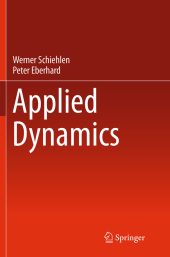 Neuerscheinungen 2016Stand: 2020-02-01 |
Schnellsuche
ISBN/Stichwort/Autor
|
Herderstraße 10
10625 Berlin
Tel.: 030 315 714 16
Fax 030 315 714 14
info@buchspektrum.de |

Peter Eberhard, Werner Schiehlen
(Beteiligte)
Applied Dynamics
Softcover reprint of the original 1st ed. 2014. 2016. xi, 215 S. 75 SW-Abb., 3 Farbabb. 235 mm
Verlag/Jahr: SPRINGER, BERLIN; SPRINGER INTERNATIONAL PUBLISHING 2016
ISBN: 3-319-37457-5 (3319374575)
Neue ISBN: 978-3-319-37457-4 (9783319374574)
Preis und Lieferzeit: Bitte klicken
Applied Dynamics is an important branch of engineering mechanics widely applied to mechanical and automotive engineering, aerospace and biomechanics as well as control engineering and mechatronics. The computational methods presented are based on common fundamentals. For this purpose analytical mechanics turns out to be very useful where D´Alembert´s principle in the Lagrangian formulation proves to be most efficient. The method of multibody systems, finite element systems and continuous systems are treated consistently. Thus, students get a much better understanding of dynamical phenomena, and engineers in design and development departments using computer codes may check the results more easily by choosing models of different complexity for vibration and stress analysis.
Introduction.- Purpose of applied dynamics.- Contribution of analytical mechanics.- Modeling of mechanical systems.- Multibody systems.- Finite-Element systems.- Continuous systems.- Flexible multibody systems.- Choice of a mechanical model.- Degrees of freedom.- Basics of kinematics.- Free systems.- Kinematics of a point.- Kinematics of the rigid body.- Kinematics of the continuum.- Holonomic systems.- Point systems.- Multibody systems.- Continuum.- Nonholonomic systems.- Relative motion of the coordinate frame.- Moving coordinate system.- Free and holonomic systems.- Nonholonomic systems.- Linearization of the kinematics.- Basics of dynamics.- Dynamics of a point.- Newtons equations.- Types of forces.- Dynamics of the rigid body.- Newtons and Eulers equations.- Mass geometry of the rigid body.- Relative motion of coordinate systems.- Dynamics of the continuum.- Cauchys equations.- Hookes material law.- Reaction stresses.- Principles of mechanics.- Principle of virtual work.- Principle of d´Alembert, Jourdain and Gauss.- Principle of minimal potential energy.- Hamiltons principle.- Lagrange equations of first kind.- Lagrange equations of second kind.- Multibody systems.- Local equations of motion.- Newton-Euler equations.- Equations of motion of ideal systems.- Simple mutlibody systems.- General multibody systems.- Reaction forces of ideal systems.- Computation of reaction forces.- Strength estimation.- Balancing of masses in multibody systems.- Equations of motion and reaction equations of non ideal systems.- Gyroscopic equations of satellites.- Formalisms for multibody systems.- Non recursive formalisms.- Recursive formalisms.- Finite-Elemente systems.- Local equations of motion.- Tetrahedral elements.- Spatial beam element.- Global equations of motion.- Beam systems.- Strength computations.- Continuous systems.- Local equations of motion.- Eigen functions of bars.- Global equations of motion.- State equations of mechanical systems.- Nonlinear state equations.- Linear state equations.- Transformation of linear equations.- Normal forms.- Numerical equations.- Integration of nonlinear differential equations.- Linear algebra for time variant systems.- Comparison of mechanical models.- Appendix.- A Mathematical tools.- Representation of functions.- Matrix algebra.- Matrix analysis.- List of important variables.- Bibliography.- Index.
From the book reviews:
"The book is devoted to technical dynamics which has now many applications in science, in mechanical engineering, in transport vehicle and control problems. ... The book is addressed to graduate students, engineers and researches." (Bozhidar Cheshankov, zbMATH 1306.70001, 2015)


